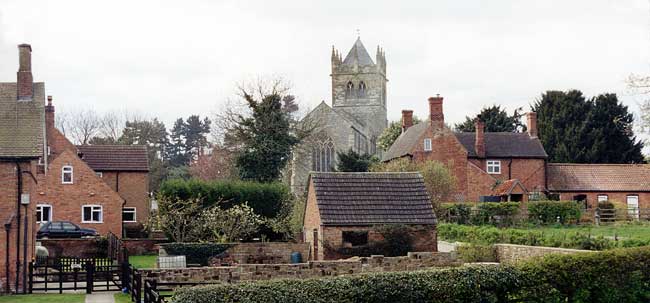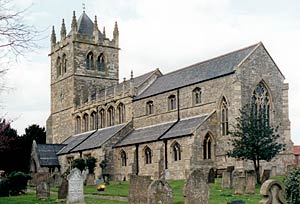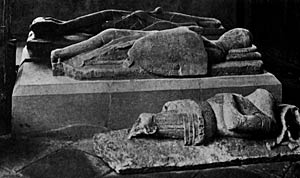< Previous | Contents | Next >
Life as in Feudal Days

Laxton in 2002.
LAXTON. With houses dotted among a wealth of trees, on a ridge of land dropping sharply down to a stream, quiet old-world Laxton has a unique interest as the last stronghold of the open field system of cultivation evolved in medieval England. The plough land is divided into three great open fields of some 300 acres each, over which lie the scattered holdings of the tenants, and the old three-course rotation (winter corn, spring corn, and fallow) is still preserved. Stubbles and the fallow field are still grazed in common by the livestock of the tenants, and everything is carried on under the jurisdiction of the same Manorial Court. Laxton has a place for all time in the Medieval Village, the film record of feudal survivals which has been presented to the National Film Library.
It happened that as this book was passing through the press it was election day in Laxton, but the election was a kind that no other Nottinghamshire village, nor indeed any English village, holds, though in medieval days such elections were common enough. The inhabitants were choosing and swearing-in the jury which was to decide the portions of the neighbouring fields each local farmer was to own during the next twelve months.
Every year two of the three fields known as West Field, Mill Field, and South Field are cultivated, while the third remains fallow. The tenants hold their land under the lord of the manor, and his bailiff summons them to the court by ringing a bell, fining those who fail to attend twopence.
Every tenant is allotted ten strips, which may be scattered in any part of the two fields, each strip being separated from its neighbour by a grass track which may not be ploughed up even if a tenant has strips which lie side by side. The original idea of allotting the fields in this way was to ensure that each tenant shared the poor land as well as the good, and each had his fair share in keeping the hedges and ditches on their boundaries in good repair. It is the duty of the jury to see that these duties are performed, and to demand fines on court day from any who do not do their duty.
At hay harvest the grass on the tracks is mown and sold by auction, and as soon as the corn crops have been gathered the jury fix a day on which the whole stock of the village can be turned loose among the stubbles. In normal times the village cattle have grazing rights on a common field. Should they be allowed to stray and damage the growing crops on the open fields an official called the Pinder collects them into the Village Pound and informs the jury, which duly fines the owner. Such was communal village life in the olden days.
This interesting village has memories of great days when it knew the Everinghams and the Lexingtons. Three Lexington brothers who won fame in the 13th century were Robert, judge and soldier, John, Lord Keeper of the Great Seal, and Henry, Bishop of Lincoln.
Only the sites are left of its great houses. One of them stood south of the church, and traces of its fishponds are seen among the trees at the foot of a field by the old vicarage. At the end of a green lane facing the church is a big field known as the Old Hall grounds, where stood a Norman castle which became the home of the Everinghams. Since their day the land has been quarried for the buried stone, but a green mound, two courts, and a dry moat are still seen. From this site there is a fine prospect of the countryside, and a delightful view of the village.

Laxton church in 2002.
With walls of mottled grey and amber stone the church is a charming picture by the wayside, in a churchyard with trim yew hedges, a bower of slender yews, and a draped column in memory of nine men who did not come back. Attractive as it is now, the church was robbed of much of its glory when it lost some of its length and width in the rebuilding of 1860. Then the sturdy, picturesque tower (with a pyramid cap on its crown of battlements and pinnacles) was rebuilt a bay farther east. The base of the tower comes from the close of the 12th century, with a doorway and arch of the 13th, and among its gargoyles are grotesque animals, a cross-legged satyr with cloven feet, an animal ready to leap down, another with pointed cars climbing on the parapet, and a crouching man.
Beautiful outside and in is the clerestory of six windows on each side of the nave, two long lines of light in a place already ablaze with light from the plain glass. Fine pinnacles crown its splendid embattled parapet enriched with a band of quatrefoils, shields, and flowers, and in the gallery of gargoyle heads are demons with bared teeth, a bear, a laughing grotesque, and two faces close together, one showing its tongue. This clerestory was built about 1490 by Archbishop Rotherham, whose fine sculptured figure with two roebucks at his feet is in a niche on the battlement. The lofty chancel screen may be his gift, though it is much restored.
The nave arcades (of about 1200) have slightly pointed arches on tall round pillars. The chancel has beautiful medieval craftsmanship in the sedilia (adorned with angels and a canopy with tiny bosses in the vaulted roof), the double piscina with a quatrefoil between the arches, and the Easter Sepulchre with flowing tracery. In the back of the Sepulchre is an aumbry with a lovely arch. In the south wall of the chancel (at its east end) is a tiny low window less than four inches wide and 20 inches long. The font is 14th century, and from its close come the clerestory of the chancel and some of the aisle windows.
In the north aisle are remains of a fine screen set up in 1532 by Robert de Trafford, a vicar whose name is on the rail. Massive old , beams are in the chancel roof, and with the lovely old work in the nave roof are bosses of shields and flowers, and four figures at the ends of the spandrels. At the foot of the stone pilasters climbing between the clerestory windows in the nave are 14 small figures, some with books, a staff, or a chalice, others playing instruments, while some are animals.
The choir seats, the screenwork in the chancel, and the lectern with St George are in memory of a vicar for 40 years of last century; the prayer desk is to a schoolmaster and organist for 40 years till 1927; the reredos and panelling of the east wall are in memory of the third Earl Manvers, lord of the manor. But it is in the monuments of bygone days that the chief interest lies.
The chapel on the north side of the chancel belonged to the Lexingtons, and the one on the south (now gone) to the Everinghams. All the figures which remain, all more or less battered, belong to the Everinghams, three actually resting on an open table tomb of the Lexingtons. The angels adorning this tomb are said to resemble those in the Angel Choir at Lincoln, which was begun when Henry de Lexington was its bishop. The three figures lying on the tomb are of Adam de Everingham the Elder (who died about 1336) and his two wives. Adam is a knight in chain mail with a belted cloak and sword, his legs crossed, his feet on a lion, and his hands at prayer. His wives are in similar dress, but it is Margaret, the second wife, who arrests attention, for she lies carved in oak, and is the only wooden figure left in the county. So well does the oak blend with the stone of the other figures that its nature is not easily seen at a casual glance. Over her long gown she wears a mantle of many folds, the drapery caught up under her arm. Her hands are gone, her features are still discernible, traces of her wimple are seen, and her headdress, held by a band, falls on to her shoulders. Her head rests on two cushions, and a dog is at her feet.

Everingham effigies in Laxton church.
Three knights of the family lie on the south side of the chancel. Two are of stone, with crossed legs; the other is a headless trunk with one arm but no hand, all that is left of Baron Reginald Everingham, the last of his race, who died in 1399. The middle one of the three is Robert de Everingham of 1287, the oldest of all the figures, and the last of the Chief Lords and Keepers of the Royal Forests. The third is a 14th century Adam de Everingham, perhaps the son of Adam who lies here with his wives.
